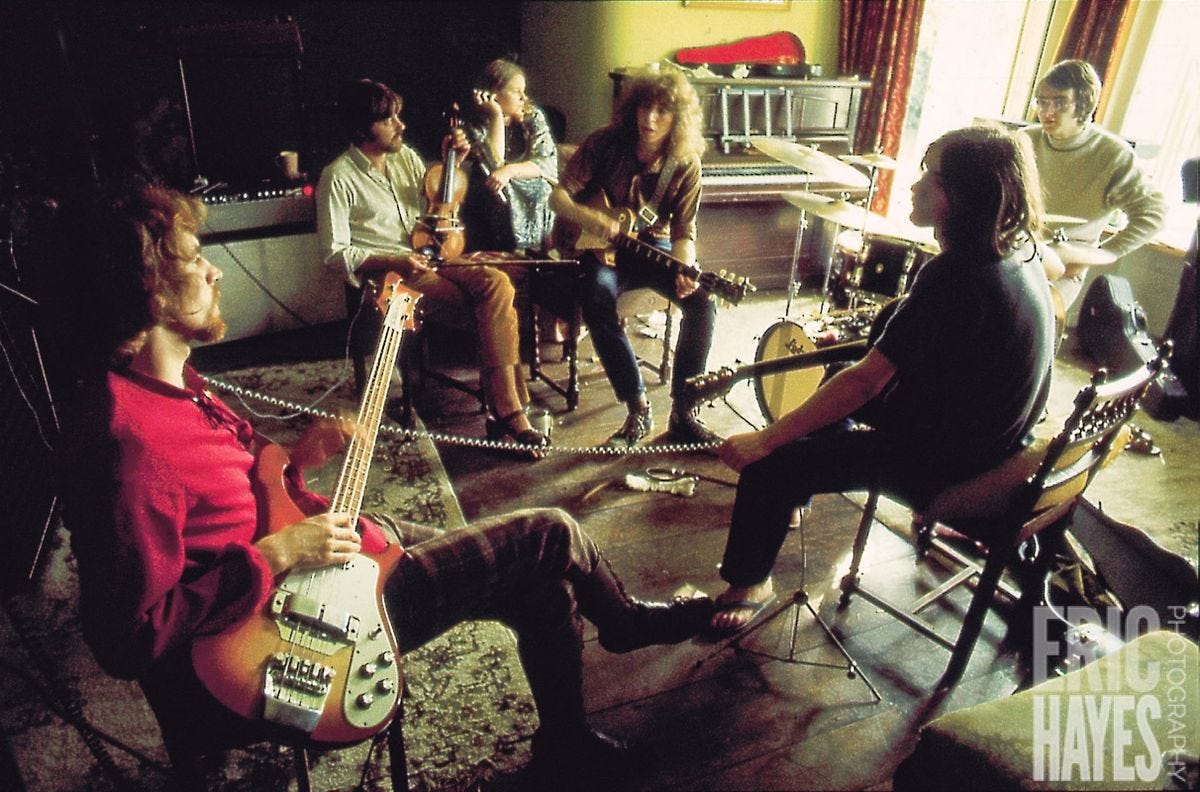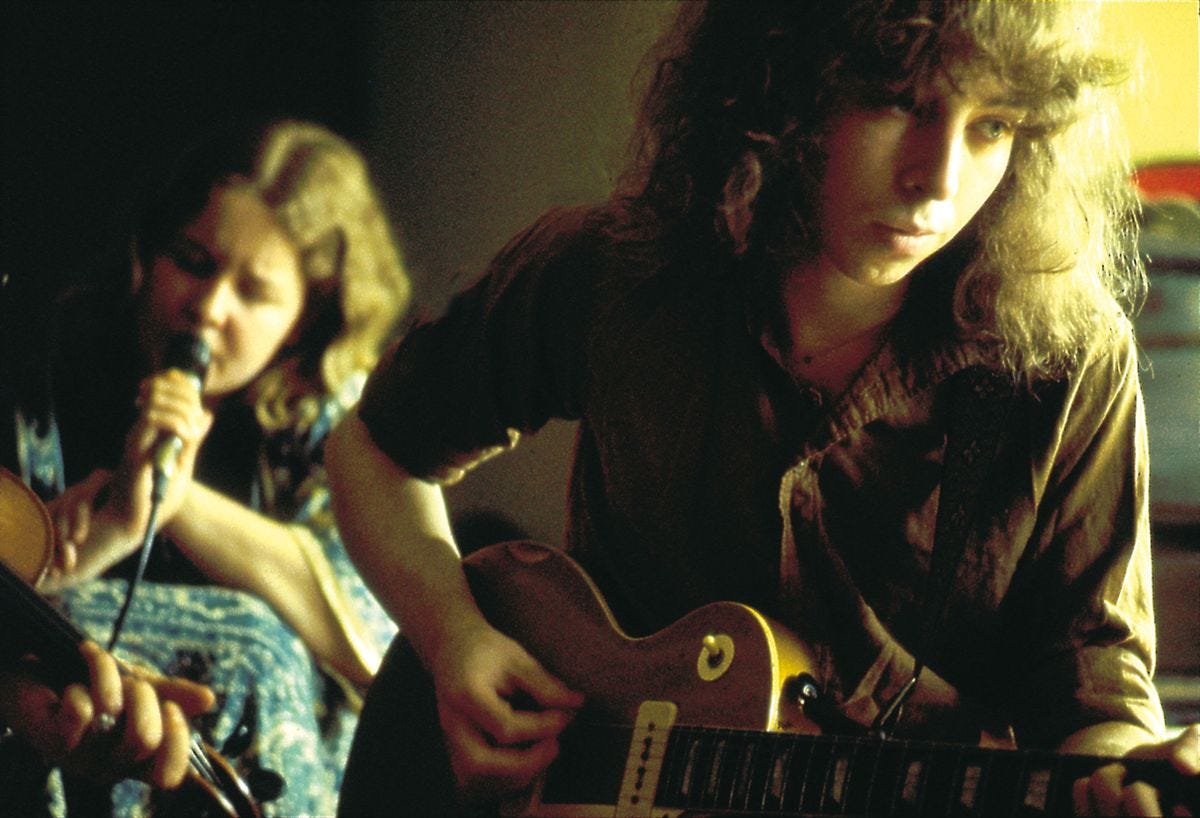As a kid and budding musician growing up in Detroit during the 1970s and 80s, I had never heard of Fairport Convention. I don’t ever remember hearing them on the radio and none of my friends—almost all of them huge music afficionados with ginormous record collections ranging from the popular to the arcane—ever mentioned them. It wasn’t until 1985 when my now ex-wife introduced me to them. She was a few years older than I and she played the violin, so every rock group on the planet with a violin player had always been on her radar. Knowing how much I like folk music and more than familiar with the way I played the guitar, she turned me on to Fairport’s classic album Liege & Lief, probably the greatest folk-rock album EVER. She gave me two wonderful things: my son, Brendan, and Fairport Convention. She got the house and everything else.
Around when we first met, on a sultry night in August she took me to The Ark, the great folk club in Ann Arbor, Michigan (at “the old Ark”—iykyk), to see the recently resurrected and reconfigured Fairport. The Ark is a small club and we sat right up front. It was a great show, but what I remember most was the sense of humor of the band. When talking about former member Richard Thompson, they mentioned he had a drinking problem, to which bass player and mandolinist Dave Pegg quipped, “I’ll say!—he doesn’t drink!” And I’ll never forget Simon Nicol saying, “On the other hand…four fingers and a thumb,” a line I have been annoying my children with for decades.
On the way home, we could see a storm was brewing. I guess she was pretty caught up in the neo-pagan vibe that Fairport tends to evoke and asked me to stop the car near a cornfield. She got out, walked a few yards into the field, and pulled some dagger out of her purse and started doing some weird Starhawk kind of shit. I was like, “This is crazy. Get in the car.” I do not recall how I coaxed her back into the vehicle; but she’s not there anymore, so I must have.
A few years later, she and I were asked to join a few friends to play a benefit or something at St. Andrew’s Hall, a great small concert venue in Detroit. One of the songs we played was what is perhaps one of my favorite all-time songs—and probably the first one I ever heard by Fairport, seeing it’s the first track on Liege & Lief—the glorious “Come All Ye.”
So, come all ye rolling minstrels And together we will try To rouse the spirit of the earth And move the rolling sky
”Come All Ye” was written by Sandy Denny and Ashley Hutchings, both of whom left the group not long after the release of the album. What a sad day in music history. But I’m getting ahead of myself.
Fairport Convention was formed in 1967 by bass player Hutchings and guitarists Nicol and Thompson. Hutchings, the old man of the three was twenty-two, while Thompson was eighteen and Nicol only sixteen. Before long they added drummer Martin Lamble and singers Judy Dyble and Iain Matthews and recorded the first eponymously titled album in late 1967 and released it in June of 1968. Not bad for a bunch of kids. Drawing more on California and American folk than their latter work, it is not the greatest album in the world. It’s okay. But had this been their only album, they would have slipped into obscurity like so many bands over the eons.
But they were scrappy—and productive. After the first album was released Dyble left the band (some might say “she was booted”) and replaced by Sandy Denny—one of the great hires in music history. Not even six months following their debut, they released What We Did on Our Summer Holidays, which, due to Denny’s influence, started to show some signs of indigenous British folk traditions that would so characterize their career. The album’s opening track, Denny’s composition “Fotheringay” exemplifies this aesthetic.
Another highlight—definitely a “shapes of things to come” phenomenon—is Richard Thompson’s first composition, “Meet on the Ledge.” It’s stunning that a boy so young could capture such wisdom in a song. It’s such a great song that Fairport—with or without Thompson—has ever finished their concerts with it. But I have a confession: I am not crazy about the original version. But this one by the man himself captures it perfectly:
The band recorded their next album, Unhalfbricking, in the first half of 1969. Of the eight tracks, three were Dylan songs—the songwriters of the band still finding their bearings. The high point of what is still a very good album is Sandy Denny’s masterpiece, “Who Knows Where the Time Goes?” written when she was nineteen—and only the second song she’d ever completed. As with “Meet on the Ledge,” it reveals a wisdom far beyond her tender years:
Tragically, one month after recording the album and two months before its release, the band was involved in an automobile accident on the way back from a gig and drummer Martin Lamble and Thompson’s girlfriend Jeannie Franklyn were both killed. It hardly needs to be said that the survivors were deeply traumatized. Decades latter they still admitted to its aftermath.
Despite the tragedy, Fairport fared forth—and less than six months later had not only replaced Lamble with Dave Mattacks and added Dave Swarbrick (who appears on Unhalfbricking) full-time on fiddle, but recorded and released their signature album, Liege & Lief. Considering what they’d been through, this is a remarkable achievement. And, by the way, Thompson was only twenty, Denny twenty-two, and Nicol had just turned nineteen a few days before recording began. Gone were the Dylan and Joni Mitchell covers as the band both developed and flexed their own songwriting prowess and mined the British folk tradition for both material and inspiration. I could share the entire album, but I will settle on a couple representative examples, the aforementioned “Come All Ye” and their take on the folksong “Matty Groves.” You can hear how the band, with the triumvirate of Sandy Denny, Richard Thompson, and Dave Swarbrick, now seasoned by experience and tragedy respond and resound to one another as they opened up a new dimension in music.
As I mentioned, after the release of Liege & Lief, both Denny and Hutchings left the band. As Hutchings later observed, he was clearly dealing with the unprocessed trauma from the accident and the deaths of their friends. Hutchings went on to found Steeleye Span and later the Albion Band while Denny started Fotheringay and then went on to a solo career that never really went anywhere. They were great bands, but never achieved anything like that pure moment of Liege & Lief. But who could? Denny died tragically at the age of thirty-one after hurting her head in a couple of falls. Her behavior in previous years had been erratic, though the reasons are unknown. Nevertheless, hers was a special gift and any time we had with her is a blessing.
Following the departure of Denny and Hutchings, Fairport soldiered on, adding wildman Dave Pegg on bass and mandolin. He’s been in the group ever since (yes, they are still going) and started the annual Cropredy Festival in 1976 to bring Fairport and Fairport adjacent musicians together to make music and make merry (Robert Plant is a regular visitor). The first album with Pegg (and the last with Thompson) is Full House, recorded and released in 1970. It’s a rollicking good time of a record, nowhere so evident as in the high comedy of the lyrics to “Walk a While.” This verse still gives me a chuckle every time I hear it:
Two miles down the road, Henry Tompkins’ wife Three miles down the road and he’s running for his life
LOL.
And here is Fairport playing live in 1970, soon after Pegg joined the band:
You may, gentle reader, at this point be wondering why I haven’t posted any live footage with the Liege & Lief line-up. That’s because there isn’t any. O tempora, o mores! And you know why that is: BECAUSE THERE IS NO JUSTICE IN THIS WORLD. THAT’S WHY!
Though Fairport has sailed on for many, many years, running through innumerable personnel changes, for me, after Thompson left following Full House, the golden moment was over. But what a moment it was.
As an added treat, here is the lovely Olivia Chaney performing “Who Knows Where the Time Goes?” with Richard Thompson in 2019, before the world went completely mad.




Like you, I became a belated and a bit besotted fan thanks to a now departed friend who played Liege and Lief for me one afternoon and let me borrow the LP. I already knew “Who Knows Where the Time Goes” from the Judy Collins cover version and I was struck by the depth not only of Denny’s vocal but of that extraordinary guitar solo. It remains one of my favorite recordings of all time. One minor correction, it was Iain Matthews (later of Matthews Southern Comfort) who was an early vocalist with the band; Ian McDonald was in King Crimson.
I’ve you to blame for my slight obsession with Fairport since you posted about them in one of your playlist posts months ago. Love them, especially the Denny era. The Sky Arts documentary is well worth a watch and on the tube. As is a haunting vocal isolation Battle of Evermore track, her voice and Plants spiralling in and out of each other is otherworldly! Sandy Denny truly was special.
Ps. Need more playlists. How about one related to whatever it is you do in house church??